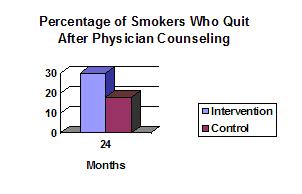Program Highlights
Program Materials
Preview or download materials
Program Scores
The Need
Cigarette smoking is the leading cause of preventable morbidity and mortality in the United States. Smoking-related medical care expenditures are estimated to be over $50 billion annually. The literature suggests that smokers who receive even brief clinical interventions, such as those from primary care physicians, significantly increase their cessation rates. More than 70% of smokers have contact with a physician each year. Primary care physicians have multiple occasions to provide personalized cessation interventions to patients who smoke.
The Program
The Physicians Counseling Smoking Program is a multi-component office-based intervention to increase the effectiveness of primary care physician-delivered smoking cessation interventions. The intervention was based on: the National Cancer Institute's 4-A Counseling model; "academic detailing," a form of educational outreach featuring personal educational visits to clinicians in their own practice setting; and the Transtheoretical Model of Change, applied to both patients' smoking behavior and physician counseling practices. PCS provides resources to help physicians counsel their patients about how to stop smoking and how to create an atmosphere in the office conducive to quitting; information on how to best involve office staff in smoking cessation; and lists of treatment programs in the community.
Community Preventive Services Task Force Finding
 This program uses an intervention approach recommended by the Community Preventive Services Task Force: provider reminders when used alone (Tobacco Control).
This program uses an intervention approach recommended by the Community Preventive Services Task Force: provider reminders when used alone (Tobacco Control).
Time Required
Intervention requires the use of Office Practice Consultants to make four to five physician-centered visits to the office practice. Intervention time varied from a few minutes to a 2-3 hour counseling training session. Time required to adopt and practice PCS varies by stage of change for physicians relative to their current smoking cessation counseling.
Intended Audience
Participants were primary care physicians and also adult, self-identified smokers from Providence, Bristol, Kent, Newport, and Washington counties in Rhode Island who were American Indian, Asian, Black, Hispanic, and White.
Suitable Settings
The program is implemented in offices of primary care physicians.
Required Resources
The "Medical Practice Resource File" is required for implementation of the program. The file contains materials for nurses, physicians, pre-contemplators and contemplators, action materials, office support materials, and newsletters. Masters-level Office Practice Consultants are required to make the physician-centered office visits to encourage the adoption of cessation counseling and familiarize staff with the resource file.
About the Study
Five Rhode Island counties were used to examine the effects of disseminating PCS by recruiting community-based samples of physicians (N = 259) and their patients who smoked (N = 4,295). Three study groups were created from the five counties: 1) the PCS group, 2) the delayed PCS group (control), 3) and the no intervention group (control). Concurrent to the delivery or delay of PCS, one-half of the sample from each of the two groups was randomized to receive or not receive a home-based smoking cessation intervention developed by collaborative investigators.
Physicians in the PCS group were initially assessed by Office Practice Consultants (OPC) on their knowledge, attitudes and behavior regarding physician-delivered cessation interventions. Based on their assessments, OPC tailored intervention based on the physicians' stage of change for adopting or improving cessation counseling. Three to four additional training visits were provided by OPC and office staff with a smoking cessation resource file. The resource file included patient education materials, means to identify and track smokers, referral information, and additional visual prompts that cued appropriate counseling strategies for specific stages of change for smoking cessation.
Physicians in the control groups received only a packet of printed materials about smoking cessation interventions.
Program outcomes included:
- At 24 months, the quit rate among smokers in the PCS counties was 25% compared to 20% in the control counties.

- Smokers who were advised to quit by a physician in the PCS group were more likely to quit than those smokers advised to quit by a physician in the control group.



